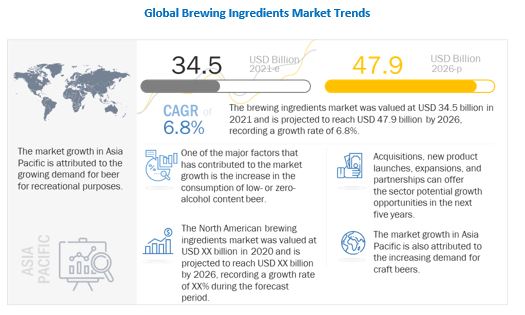Brewing Ingredients Market to Record Steady Growth by 2026
The global brewing ingredients market was valued 34.5 billion in 2021 and is projected to reach USD 47.9 billion by 2026, growing at a CAGR of 6.8% during the study period. The rise in demand for beers from all over the globe coupled with increasing consumption of craft beers will drive the market demand and growth of brewing ingredients globally. Various opportunities in near future such as introduction of new flavors in the beer market and increase in demand for organic beers will boost the demand of brewing ingredients market globally.

According to the Organic Trade Association, US organic beer sales increased more than tenfold since 2003, from USD 9 million to USD 92 million in 2014. Peak Organic Brewing Co. offers organic beers of different types, such as ale and pilsner. Consumer are becoming more aware about their intake which is resulting in the increasing in the demand for organic products and clean label food & beverages with maximum use of natural raw materials with information regarding the traceability of the raw materials used. The concern for traces of pesticides has also resulted in a rise in demand for organic beer, which provide a major opportunity to the brewing ingredients manufactures.
Download PDF Brochure: https://www.marketsandmarkets.com/pdfdownloadNew.asp?id=248523644
By source, the malt extract segment is estimated to hold the largest share in the brewing ingredients market
The market includes five major sources: malt extract, adjuncts/grains, hops, beer yeast, and beer additives. The malt extract segment is further bifurcated into standard malt and specialty malts. Brewing-grade malt extracts are made with the highest-quality brewing malts and get additional colors and flavors from using specialty malts. This gives beer the unique character and flavor desired for the particular style brew. These malts often have a longer time in the kiln, at higher temperatures, or get roasted to add depth, complexity, and flavor to the resulting beer. Specialty malts include less in the way of sugars but have a greater influence on the color of the beer. These malts are widely used in craft beers.
By brewery size, the craft brewery is estimated to grow at a higher growth rate in the brewing ingredients market.
According to the Brewers Association, an American craft brewer is a small and independent brewer, where small breweries have an annual production of 6 million barrels of beer or less. The craft brewing industry contributed USD 82.9 billion to the US economy in 2019, with more than 580,000 employees. The average alcohol by volume (ABV) content of a craft beer is 5% to 10%, but some of the most popular craft beers have an ABV of as high as 40%. On the other hand, beer produced in bulk by macro breweries has an ABV of 4% to 6% and as little as 2%. Craft breweries offer different flavors, which allow consumers with different tastes to cater to their preferences. These factors are driving the growth of the craft brewery segment in the global market.
Request Sample pages: https://www.marketsandmarkets.com/requestsampleNew.asp?id=248523644
The increasing demand for beers in the Asia Pacific countries drives the region's growth rate at a higher pace.
The Asia Pacific region comprises two high-growth economies: India and China. The drinking preferences of the population in this region are gradually shifting toward alcoholic culture. The large, increasing population and the growing market mean that the demand for brewing ingredients is still promising. Another factor is the densely populated areas that are not completely tapped by beer manufacturing and brewing ingredient companies. Hence, beer produced in macro breweries and craft breweries still has a high-growth rate. Moreover, the increasing spending capacity of consumers has led to a surge in demand for craft beers. There has been an emergence of various craft breweries in countries such as India over the last few years.



